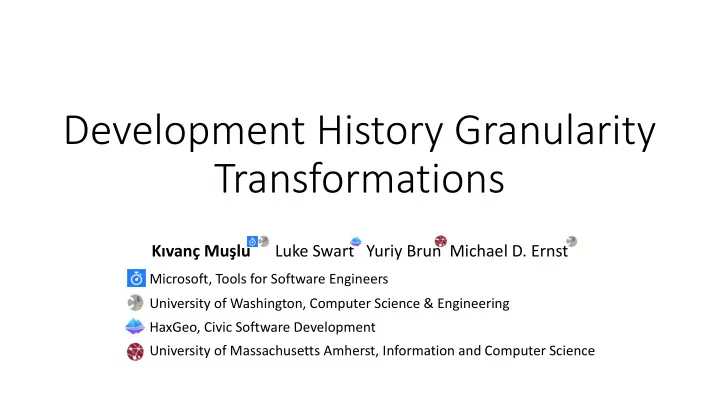

Development History Granularity Transformations Kıvanç Muşlu Luke Swart Yuriy Brun Michael D. Ernst Microsoft, Tools for Software Engineers University of Washington, Computer Science & Engineering HaxGeo, Civic Software Development University of Massachusetts Amherst, Information and Computer Science
Development histories simplify tasks Development histories are used to: • localize bugs • rollback mistakes • understanding software evolution • predicting failures • …
Different tasks require different granularities Why does my test fail? binary search history How can I retrieve discarded code? custom compilable code raw history (thin) slice history keystroke How did a feature evolve?
Problem: development histories are inflexible public static void m a i n public static void main • automatically-managed histories [YoonM11, Mahoney12, NegaraCDJ14] • Fine-grained: extracting relevant information requires post processing • manually-managed histories • Incomplete: might miss information • Course-grained: information might be intermingled with irrelevant one
Solution: multi-grained development histories Our contribution: make recording granularity transparent • record a complete & fine-grained history • automatically transform this history into more optimal granularities for the task at hand
Solution: multi-grained development histories ? ? ? ? ? ?
Outline Transformations Design
Transformations granularity transformations (group changes that satisfy … and reorder history such that …) transformation operations (intermediate operations) transformation primitives expand, collapse, group
Primitives: expand, collapse, and move e 1 e 2 e 3 e 4 e 5 collapse(2, 4) e 1 e 2 e 3 e 6 e 4 e 5
Primitives: expand, collapse, and move e 1 e 2 e 3 e 4 e 5 collapse(2, 4) e 1 e 2 e 3 e 4 e 5
Primitives: expand, collapse, and move e 1 e 2 e 3 e 4 e 5 collapse(2, 4) e 1 e 2 e 6 e 3 e 4 e 5 expand(2) e 1 e 2 e 3 e 4 e 5
Primitives: expand, collapse, and move e 1 e 2 e 3 e 4 e 5 move(5,2) e 1 e 5' e 2' e 3' e 4'
Operation: group (move + collapse) e 1 e 2 e 3 e 4 e 5 e 6 e 7 1 2 1 1 2 3 2 move(3,2) & move(4, 3) move(7, 6) e 1 e 3' e 4' e 2' e 5 e 7' e 6' 1 1 1 2 2 2 3 e 1 e 3' e 4' e 2' e 5 e 7' e 6' collapse(1, 3) collapse(2, 4) e 8 e 9 e 6'
Transformation: GroupCompilable (group) 1 2 3 3 3 4 4 e 1 e 2 e 3 e 4 e 5 e 6 e 7 e 1 e 2 e 3 e 4 e 5 e 6 e 7 e 1 e 2 e 8 e 9
All transformations • GroupCompilable: group(collapse) • GroupFiles: group(collapse + move) • for each modified file, creates a group containing all edits on this file • useful for manual inspection (e.g., VCS diff) • GroupCollocated: expand + group(collapse + move) • creates a group for each contiguous edit • useful for separating tangled changes
Codebase Manipulation: a design for multi-grained histories
Codebase Manipulation: a design for multi-grained histories
Codebase Manipulation: a design for multi-grained histories
Codebase Manipulation: a design for multi-grained histories
Contributions • identify inflexibility problem of the current development histories • propose multi-grained histories • Builds on three primitives: collapse, expand, move • History is automatically recorded • Developer uses the most optimal granularity for the current task • Codebase Manipulation: one design for multi-grained histories
Recommend
More recommend